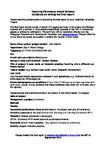A case study on inclusive practice: Deciding who’s different and what’s needed
| dc.contributor.author | Osborn, J | |
| dc.contributor.author | Dickens, D | |
| dc.date.accessioned | 2018-08-31T08:26:37Z | |
| dc.date.available | 2018-08-31T08:26:37Z | |
| dc.date.issued | 2012 | |
| dc.identifier.uri | http://hdl.handle.net/10026.1/12210 | |
| dc.description | File replaced (incorrect version) on 01/08/2022 by KT (LDS). | |
| dc.description.abstract |
Using a case study design this project considers the challenges of implementing inclusive practise in order to enhance the quality of learning and teaching at an individual and subject level. Ultimately the aim was to identify systemic barriers to inclusion and suggest strategies that can be employed to mediate the effects. Previous research has highlighted practices that promote inclusive practice (Waterfield & West, 2002). Checklists and advice are widely available to institutions who are keen to promote the inclusion of disabled learners. This research builds upon this knowledge and considers why these practices fail to meet the desired aims. Contextual factors are likely to have an impact on inclusive practice. For example, funding to support inclusive practice is likely to influence how this is provided. Whilst wider contextual issues are likely to have an influence other factors such as individual staff attitudes are also likely to play a part. Using a case study approach allows the phenomenon to be studied so that both contextual and attitudinal issues can be considered. The literature review confirmed many core themes in relation to including disabled learners. Whilst there is a wealth of research available on inclusive practices there is acknowledgement that more needs to happen. The HEFCE review of its policy as it relates to disabled students concludes that whilst much progress has been made still more needs to be done to move towards disability equality (Arnold, 2009). The report recommends developing ‘.. inclusive institutional cultures that embody a social model of disability .. that are anticipatory, proactive and flexible in nature.’ This suggests that wider reforms needs to take place rather than piecemeal changes. Other authors also promote social model practices (Barnes, 2006; Shakespeare & Watson, 1997) and practitioners called on to anticipate adjustments and comply with Special Educational Needs and Disability Act (2001) (SENDA). The literature highlights a wealth of information suggesting how the environment can be altered and teaching and learning adjusted so that it provides an inclusive experience (Thomas & May, 2010). Despite legislation and guidelines on inclusive practices some difficulties still remain. Most notably some students are still reluctant to disclose disability for fear of stigma and prejudice and also because they do not identify with the term disability (Borland & James, 1999). Disabled students who do not disclose still need adjustments and institutions therefore need to consider inclusive practices that can accommodate these needs. This project explores how inclusive practice is provided and how these difficulties are addressed. The literature suggests that ‘how to’ guides are useful but cultural change is needed to ensure a more inclusive experience for disabled learners. | en_US |
| dc.description.sponsorship | TFAS | en_US |
| dc.language.iso | en | |
| dc.publisher | University of Plymouth | en |
| dc.subject | disability; support; inclusive practice | en_US |
| dc.title | A case study on inclusive practice: Deciding who’s different and what’s needed | en_US |
| dc.type | Report | en_US |
| plymouth.date-start | 2011-2012 | en_US |


